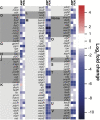Breaching the Barrier: Genome-Wide Investigation into the Role of a Primary Amine in Promoting E. coli Outer-Membrane Passage and Growth Inhibition by Ampicillin
- PMID: 36409154
- PMCID: PMC9769794
- DOI: 10.1128/spectrum.03593-22
Breaching the Barrier: Genome-Wide Investigation into the Role of a Primary Amine in Promoting E. coli Outer-Membrane Passage and Growth Inhibition by Ampicillin
Abstract
Gram-negative bacteria are problematic for antibiotic development due to the low permeability of their cell envelopes. To rationally design new antibiotics capable of breaching this barrier, more information is required about the specific components of the cell envelope that prevent the passage of compounds with different physiochemical properties. Ampicillin and benzylpenicillin are β-lactam antibiotics with identical chemical structures except for a clever synthetic addition of a primary amine group in ampicillin, which promotes its accumulation in Gram-negatives. Previous work showed that ampicillin is better able to pass through the outer membrane porin OmpF in Escherichia coli compared to benzylpenicillin. It is not known, however, how the primary amine may affect interaction with other cell envelope components. This study applied TraDIS to identify genes that affect E. coli fitness in the presence of equivalent subinhibitory concentrations of ampicillin and benzylpenicillin, with a focus on the cell envelope. Insertions that compromised the outer membrane, particularly the lipopolysaccharide layer, were found to decrease fitness under benzylpenicillin exposure, but had less effect on fitness under ampicillin treatment. These results align with expectations if benzylpenicillin is poorly able to pass through porins. Disruption of genes encoding the AcrAB-TolC efflux system were detrimental to survival under both antibiotics, but particularly ampicillin. Indeed, insertions in these genes and regulators of acrAB-tolC expression were differentially selected under ampicillin treatment to a greater extent than insertions in ompF. These results suggest that maintaining ampicillin efflux may be more significant to E. coli survival than full inhibition of OmpF-mediated uptake. IMPORTANCE Due to the growing antibiotic resistance crisis, there is a critical need to develop new antibiotics, particularly compounds capable of targeting high-priority antibiotic-resistant Gram-negative pathogens. In order to develop new compounds capable of overcoming resistance a greater understanding of how Gram-negative bacteria are able to prevent the uptake and accumulation of many antibiotics is required. This study used a novel genome wide approach to investigate the significance of a primary amine group as a chemical feature that promotes the uptake and accumulation of compounds in the Gram-negative model organism Escherichia coli. The results support previous biochemical observations that the primary amine promotes passage through the outer membrane porin OmpF, but also highlight active efflux as a major resistance factor.
Keywords: Gram-negative bacteria; efflux pumps; outer membrane.
Conflict of interest statement
The authors declare no conflict of interest.
Figures


Similar articles
-
Klebsiella pneumoniae Major Porins OmpK35 and OmpK36 Allow More Efficient Diffusion of β-Lactams than Their Escherichia coli Homologs OmpF and OmpC.J Bacteriol. 2016 Nov 4;198(23):3200-3208. doi: 10.1128/JB.00590-16. Print 2016 Dec 1. J Bacteriol. 2016. PMID: 27645385 Free PMC article.
-
Synergy between Active Efflux and Outer Membrane Diffusion Defines Rules of Antibiotic Permeation into Gram-Negative Bacteria.mBio. 2017 Oct 31;8(5):e01172-17. doi: 10.1128/mBio.01172-17. mBio. 2017. PMID: 29089426 Free PMC article.
-
Role of internal loop dynamics in antibiotic permeability of outer membrane porins.Proc Natl Acad Sci U S A. 2022 Feb 22;119(8):e2117009119. doi: 10.1073/pnas.2117009119. Proc Natl Acad Sci U S A. 2022. PMID: 35193963 Free PMC article.
-
Breaching the Barrier: Quantifying Antibiotic Permeability across Gram-negative Bacterial Membranes.J Mol Biol. 2019 Aug 23;431(18):3531-3546. doi: 10.1016/j.jmb.2019.03.031. Epub 2019 Apr 5. J Mol Biol. 2019. PMID: 30959052 Review.
-
Porins and small-molecule translocation across the outer membrane of Gram-negative bacteria.Nat Rev Microbiol. 2020 Mar;18(3):164-176. doi: 10.1038/s41579-019-0294-2. Epub 2019 Dec 2. Nat Rev Microbiol. 2020. PMID: 31792365 Review.
Cited by
-
Emergence of the Dickeya genus involved duplication of the OmpF porin and the adaptation of the EnvZ-OmpR signaling network.Microbiol Spectr. 2023 Aug 29;11(5):e0083323. doi: 10.1128/spectrum.00833-23. Online ahead of print. Microbiol Spectr. 2023. PMID: 37642428 Free PMC article.
-
Using permeation guidelines to design new antibiotics-A PASsagE into Pseudomonas aeruginosa.Clin Transl Med. 2024 Mar;14(3):e1600. doi: 10.1002/ctm2.1600. Clin Transl Med. 2024. PMID: 38426413 Free PMC article. No abstract available.
-
A method to correct for local alterations in DNA copy number that bias functional genomics assays applied to antibiotic-treated bacteria.mSystems. 2024 Apr 16;9(4):e0066523. doi: 10.1128/msystems.00665-23. Epub 2024 Mar 12. mSystems. 2024. PMID: 38470252 Free PMC article.
References
-
- Tacconelli E, Carrara E, Savoldi A, Harbarth S, Mendelson M, Monnet DL, Pulcini C, Kahlmeter G, Kluytmans J, Carmeli Y, Ouellette M, Outterson K, Patel J, Cavaleri M, Cox EM, Houchens CR, Grayson ML, Hansen P, Singh N, Theuretzbacher U, Magrini N, WHO Pathogens Priority List Working Group . 2018. Discovery, research, and development of new antibiotics: the WHO priority list of antibiotic-resistant bacteria and tuberculosis. Lancet Infect Dis 18:318–327. doi:10.1016/S1473-3099(17)30753-3. - DOI - PubMed
Publication types
MeSH terms
Substances
LinkOut - more resources
Full Text Sources

